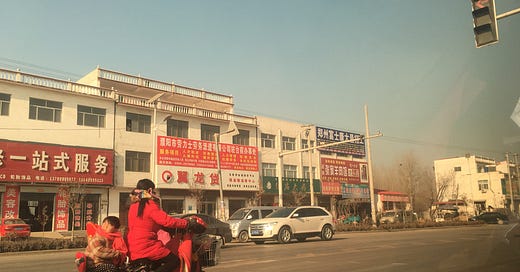A factory town in rural China, 2018
It was a decade ago and I found myself wandering around the sewing room of a massive bra factory somewhere in rural, interior China. This was a hub for bra-making, to such a degree that the place was nicknamed Bra Town. I probably don’t need to tell you, but Bra Town was a fascinating place. I’d gone there to write a story on the garment industry, one of hundreds on that subject I wrote while living in China.
As workers churned away on hundreds of sewing machines across the factory floor, I asked the boss about allegations of child labor in the garment industry. His operation manufactured high-end products, which sold at a higher price point, and the company was strict about not hiring children. By then, child labor had been illegal in China for years. He found it somewhat insulting to be asked about employing children.
The factories that did hire kids tended to be low-end and low-paying, he explained, making cheap products with slim profit margins. It seemed a point of pride to this factory boss that his was an important enough company with strong profits that they didn’t even consider putting children on the sewing floor. Only the worst companies had to resort to that.
It was then I that I remembered that thing I’d heard repeatedly over many years of reporting inside China’s manufacturing industry – that “small hands” are needed for detail work – was code for something else entirely. Small hands are not better at sewing on buttons. Small hands are not faster, nor are they more adept at placing screws on a smartphone. Children are not uniquely dexterous.
The truth, rather, is that “small hands” has been a code phrase for labor exploitation since the Industrial Revolution, when children were put to work on looms. (There's a good history here.) Smaller hands come attached to the bodies of people who are younger, have less power, less access to wealth and can be pushed into low-paid factory work. If you don’t need the tiny hands of children to place a bra fastener, what weight does that notion hold anywhere?
The notion that women and children have small hands that suits detail work in factories is a clichéd excuse for low-wage work. So imagine my surprise when a New York Times piece popped up over the weekend, quoting anonymous sources on a particularly weird assertion about why iPhone manufacturing can’t move to the United States. The answer, the anonymous “experts” told the times, lies partly in the hands of Chinese women.
“Young Chinese women have small fingers, and that has made them a valuable contributor to iPhone production because they are more nimble at installing screws and other miniature parts in a small device,” supply chain experts said. https://www.nytimes.com/2025/05/23/technology/apple-iphone-trump-india-china.html
In all my reporting inside Apple-related factories in China, I met more men working on the line than women. Why are we defaulting to this utterly bizarre decades-old claim about the hands of Chinese women? Journalist Julia Carrie Wong and others have rightly called out the comment for racism. More of that discussion is here, on social media.
Beyond the race science, the assertion about small hands has long been an excuse for companies to exploit, underpay and overwork the people who make our endless stream of consumer products. “Small hands” was a common, false reason offered for why so many women, and often children, work in the fireworks production industry, with deadly consequences. Their vulnerability has nothing to do with the size of their hands and everything to do with their lack of power in society. https://slate.com/business/2016/07/china-makes-most-of-the-worlds-fireworks-and-bears-most-of-the-danger.html
Now that the current US regime seems strangely preoccupied with using tariffs to force a private company (Apple) to move its iPhone production from China to the United States, it appears those who’ve gotten rich by spending less on paying the factory workers of China are panicking and defaulting to one of the oldest tropes around workers.
About a decade ago, I spent more than two years investigating labor violations at Apple components factories in China. I found many; the resulting investigation won a bunch of journalism awards. Not much changed, perhaps nothing at all. Apple grew more profitable and became inexorably linked to China and making its products there.
From that reporting, one particular story sticks with me. In southern China, I met a group of young workers, both men and women, who had lost most of the feeling in and use of their hands after an illegal chemical deployed at one Apple supplier factory left them with nerve damage. I met several of them in a hospital where they were recovering, another toll of China’s rise to become the world’s everything factory. The size of their hands was irrelevant. Their hands didn’t work, and they couldn’t get answers about whether they ever would again. I spent time looking at their hands; they were not unusually small. Do I even need to say that?
I’ve often wondered how things might have changed had American consumers cared more about the working conditions of people in China and elsewhere who make their things. Now with a president demanding that mass factory work return to this country, maybe it will finally sink in when people in this country get to see the consequences. A good time to remind everyone: your iPhone wasn’t made by a robot. There are humans behind all of it and everything else you buy.




My kids’s dad’s grandmother had been a lace worker in Nottingham. She was an invisible seamstress well into old age—as you probably know but a lot of people don’t, invisible seamstresses were able to do the tiny, nearly invisible mending they specialized in not because their hands were particularly small but because they were trained in that work as children.
Great piece. The NYT can go boil its head with that trash.